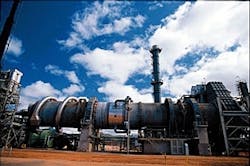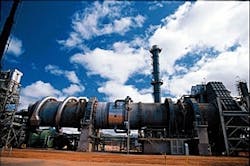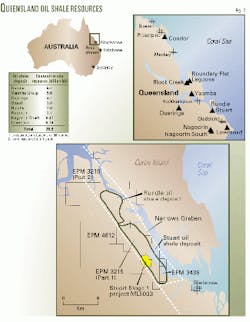Air emissions have delayed commissioning the 4,500-b/d first stage of the Stuart oil-shale pilot facility in Queensland, Australia. Start up is now expected at yearend 2000 instead of the initial yearend 1999 target, according to James D. McFarland, managing director of Southern Pacific Petroleum NL and Central Pacific Minerals NL (SPP/CPM).
These two Australian companies are in a joint venture with Suncor Energy Ltd. of Canada, the operator, to develop the estimated 3 billion bbl of in situ shale oil.
McFarland said in his presentation at the 16th World Petroleum Congress in Calgary in early June that the odors, classified as not a risk to human health, are a nuisance for residents of nearby small rural communities. The $250-million (Aus.) Stage 1 commissioning work has been slowed since early December 1999 while the project investigates solutions to alleviate the air emissions.
The Stuart project, if successful, could lead to an 85,000-b/d commercial operation by 2007 after an intermediate 14,800-b/d facility (Stage 2) further proves out the project's viability.
Stage 1, now being commissioned, will test the Alberta-Taciuk Processor (ATP) retort technology for extracting the oil from the shale (Fig. 1).
Queensland shales
McFarland described Stuart as one of several oil-shale deposits, containing an estimated 29 billion bbl of oil, discovered in the 1970s and early 1980s along the Queensland coast of eastern Australia (Fig. 2). He indicated the deposits contain some of the world's highest-quality shale resource in terms of oil yield, an average grade of 91 l./tonne (at zero moisture), and have an amenability to a new generation of oil-recovery technology.
The shale in the 400-m thick Rundle formation is near the surface, 15-25 m overburden, and therefore can be mined with open-pit operations. The formation was formed in a closed freshwater lake environment with algae deposited in fine muds providing the source for kerogen, a solid hydrocarbon that yields oil when heated. The shales have a 15-25% kerogen and 20-25% moisture content.
Plans for Stage 1 include a mined area, 1.5-km long and 400-m wide with a maximum 80-m depth. Expected recovery is 29 million bbl or 172 l./tonne (at zero moisture).
New retort technology
McFarland said the most significant feature of the Stuart project is the retorting technology, which had its roots in Canadian oil-sands research. A pilot plant in Calgary has tested the ATP technology at 80 tonnes/day of Stuart oil shale.
In the process, shale is heated to 500° C. thermally to decompose the kerogen into gas and oil as well as coke, which remains on the shale matrix.
The ATP includes a horizontal rotating vessel containing two concentric kilns through most of its length (Fig. 3). The inner kiln has two sealed compartments for preheating and retorting shale. The outer kiln provides a combustion zone and conduit for combusted shale to move in an opposite direction down the length of the kiln to transfer heat to incoming shale (Fig. 4).
Stage 1 has a single ATP retort (62.5-m length, 8.2-m diameter, and 2,500-tonne weight) that normally rotates at 4 rpm on pressurized oil-film bearings. It is designed to process 6,000 tonnes/day of shale to produce 4,500 b/d of products in the form of vapors.
Initial plans call for the facility to sell two products: a hydrotreated naphtha product with less than 1 ppm of sulfur and nitrogen, and a 27° API gravity medium shale oil (MSO) containing about 0.4 wt % sulfur and 1.1 wt % nitrogen. An on-site steam reformer fed by natural gas provides hydrogen for the process.
Project commissioning
Stage 1 construction began in August 1997 and was completed in April 1999. McFarland said the mine was successfully commissioned before completion of the plant and work on commissioning the plant began in May 1999.
To date, various parts of the facility have been commissioned, and it has produced raw naphtha and MSO to design specifications and close to design yields, at rates up to 2,500 b/d, according to McFarland.
Operators believe the odors, which have delayed final commissioning, are associated with a combination of trace hydrocarbons and sulfur components in the plant flue-gas release to the atmosphere. Plans for reducing the odor include an investigation to enhance the flue-gas scrubbing system and a contingency program for incinerating parts of the flue gas stream.
Once the emissions problem is resolved and the plant is commissioned, McFarland expects a decision on the technical and operational viability of the ATP technology to be made in early 2001.
Further stages
If Stage 1 proves out the technology, plans call for building a Stage 2 pilot adjacent to Stage 1. The $300-350 million (Aus.) Stage 2 design will handle 25,000 tonnes/day of shale feed for producing 14,800 b/d of shale oil from a single larger ATP retort. Operating costs estimates are $14-15 (Aus.)/bbl ($9-10 (US)/bbl).
The joint venture plans the commercial facility (Stage 3), if built, to have five ATP modules processing 125,000 tonnes/day of shale to produce 65,000 b/d of product. Total production rate then will be 85,000 b/d from all three stages.
The third stage has projected capital costs of $2-2.5 billion (Aus.) with operating costs of $11-12 (Aus.)/bbl ($7-8 (US)/bbl in 1996$). McFarland said a threshold West Texas intermediate oil price of $10-12/bbl (1999$) is required for Stage 3 to generate a 10% internal rate of return (IRR). At $17/bbl, Stage 3 may generate an IRR of 15-18%, he said.






